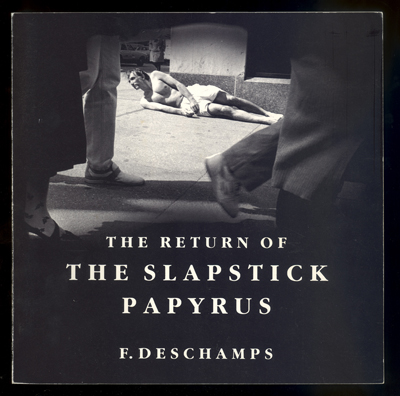
François Deschamps
The Return of the Slapstick Papyrus
Nova York, Visual Studies Workshop, 1988
19 x 19 cm.
123 p.
ISBN-13: 978-0898220513
The Return of the Slapstick é um romance visual de detetive que aborda questões relativas a imagens e poder. O volume contém 132 páginas, 87 fotografias, 17 reviravoltas e 39 partes engraçadas. O texto da sobrecapa dá algumas ideias sobre o conteúdo e onde eu queria ir com ele: “Em 1998, pouco antes da campanha Eat The Rich, Rogue Savage é contratado pelo sinistro Doutor Francisco para encontrar um misterioso pássaro grande. O irmão gêmeo de Rogue, Rusty, o famoso egiptólogo, desaparece. A adorável e inteligente professora Katherine, professora de várias línguas, guiará e talvez ensinará a Rogue o mistério das sombras por trás dos Sigma Parlors. Este conto magistral de intriga e suspense, muitas vezes parece ir a lugar nenhum e, eventualmente é isso que acontece. “Novamente, como acontece com Life in a Book, meu objetivo é tratar ideias sérias de uma forma divertida. O livro lida com questões relativas à luta pelo poder entre o Primeiro Mundo e o Mundo em Desenvolvimento. O insight culminante e a mensagem central do livro é que todo poder é baseado na separação. A chave para a narrativa é o Papiro do Palhaço, um documento de piadas de 2000 anos, que serve como um índice visual para toda a história, já que todos os desenhos no papiro são baseados em fotografias do livro. O hieróglifo é o símbolo perfeito para um livro de artista que usa imagens para criar significado, como qualquer ideograma faz. Desde que me lembro, queria contar uma história com imagens e fotografias. Isso remonta a ler os livros ilustrados de Tintin que um amigo francês dos meus pais me trouxe quando eu tinha nove anos de idade. Esses livros não apenas me impulsionaram a um interesse pela justaposição de palavras-imagens, mas também me inspiraram a viajar para lugares como a selva amazônica, o Egito, a Índia, a Indonésia e várias ilhas remotas do Pacífico. A partir dessas aventuras fotográficas, aprendi muito sobre política e outros modos de vida. Fui criado bilíngüe e passei anos em um liceu francês, estudando latim, espanhol e alemão. Essa experiência com a fungibilidade das palavras para descrever uma experiência influenciou minha visão de comunicação nos livros de artista. Outra influência importante, embora mais conflituosa, foi meu estudo da matemática culminando na busca de um doutorado. Meu pai era um cientista teórico e me encorajou neste estudo que eu não gostei. No entanto, acredito que o delicado equilíbrio entre a busca pela verdade e a elegância na matemática é uma preocupação estética profunda. Espero em meus livros fazer o mesmo tipo de argumentos fundamentados para novas formas de olhar a cultura e as estruturas políticas.
The Return of the Slapstick Papyrus is a visual detective novel which addresses issues concerning imagery and power. The volume contains 132 pages, 87 photographs, 17 odd-plot twists, and 39 funny parts. The jacket copy gives some ideas as to the content and where I wanted to go with it: “In 1998, just before the Eat the Rich Campaign, Rogue Savage is hired by the sinister Doctor Francisco to trace a mysterious large bird. Rogue’s twin brother Rusty, the notorious Egyptologist, disappears. The lovely and intelligent Professor Katherine, mistress of many languages, will guide and perhaps teach Rogue the mystery of the shadows behind the Sigma Parlors. This masterful tale of intrigue and suspense often appears to go nowhere and eventually does.” Again, as with Life in a Book, my purpose is to treat serious ideas in an entertaining manner. The book grapples with issues concerning the power struggle between the First World and the Developing World. The culminating insight and the central message of the book is that all power is based on separation. The key to the narrative is the Slapstick Papyrus, a document of 2000 year old jokes, which serves as a visual index to the entire story since all the drawings in the papyrus are based on photographs in the book. The hieroglyph is the perfect symbol for a visual artists’ book which uses imagery to create meaning, much as any ideograph does. Since I can remember, I have wanted to tell a story with images and photographs. This goes back to reading the illustrated Tintin books that a French friend of my parents brought me when I was nine years old. These books not only propelled me to an interest in word-image juxtaposition but also inspired me to travel to such places as the Amazon Jungle, Egypt, India, Indonesia, and various remote Pacific islands. From these photographic adventures, I learned an enormous amount about politics and other ways of living. I was raised bilingually and spent years in a French lycée, further studying Latin, Spanish and German. This experience with the fungibility of words to describe an experience has informed my vision for communication in artists’ books. Another important, though more conflicted influence, was my study of mathematics culminating in the pursuit of a doctoral degree. My father was a theoretical scientist and encouraged me in this study which I rather disliked. However, I believe that the delicate balance between the quest for truth and elegance in mathematics is a deep aesthetic concern. I hope in my books to make the same sort of reasoned arguments for new ways of looking at culture and political structures.
http://www.artistsbooksonline.org/works/rosp.xml
http://bookstore.vsw.org/product/the-return-of-the-slapstick-papyrus-francois-deschamps
https://www.printedmatter.org/catalog/4897/
